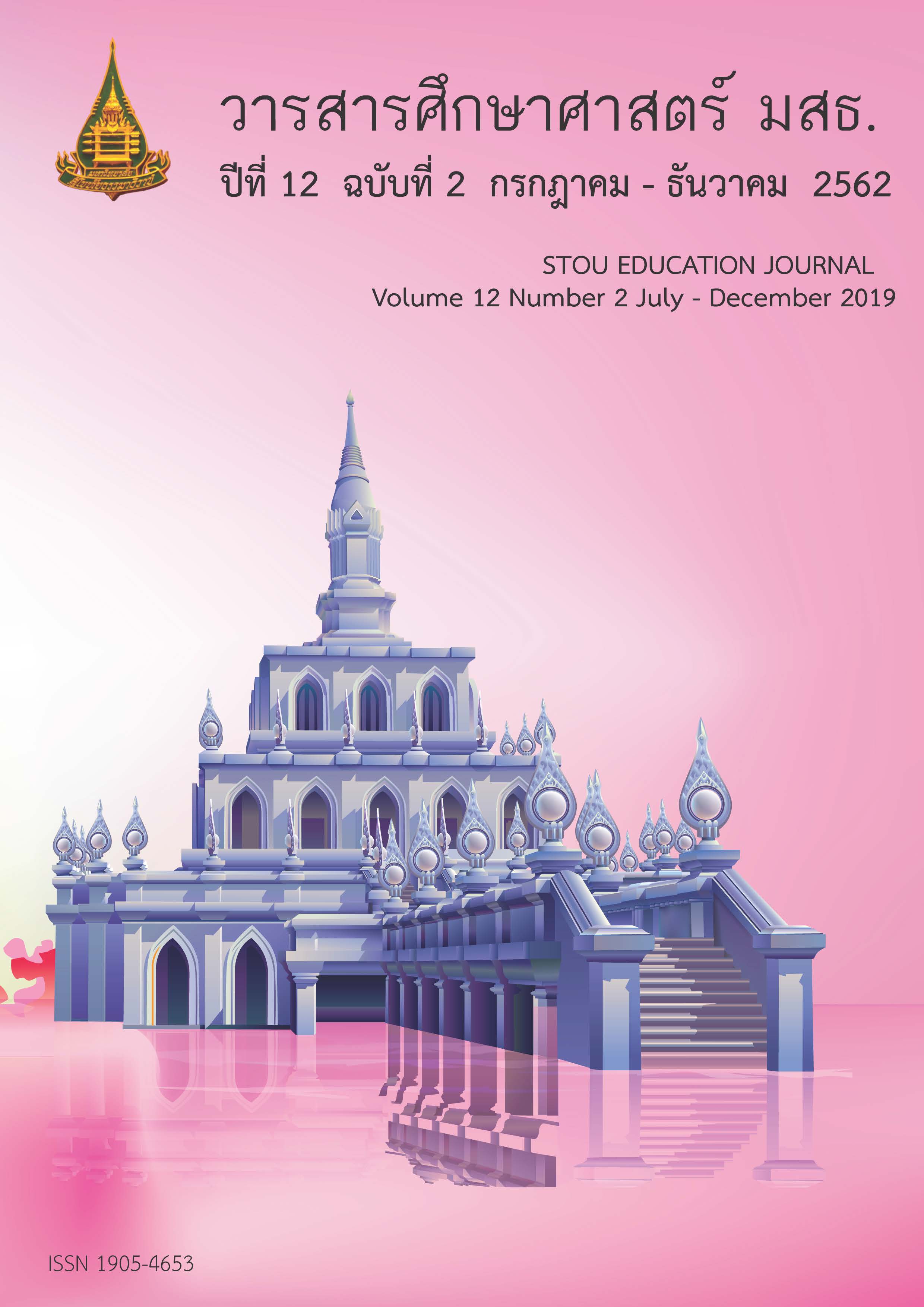How to Be a Creative Teacher for Young Creators
Main Article Content
Abstract
Early childhood teachers are key persons for developing children’s creative thinking. To do that, they must understand, value, and support children to deveop their creative thinking through everyday life activities. Besides, they need to be creative thinking model. However, Early childhood teachers, in general, cannot arrange art experiences in response to children’s nature and development. This is becasuse they lack expereinces and understanding on arranging environment that enhance creative thinking. Also they are not creative thinking models. They tend to control and frame children. On the contrary, they do not let children think, feel, or act freely although it is the key of creative thinking development. There are 3 guidlines for enhancing early childhood teachers arrange creative thinking activities for children 1) develop teachers’ positive attitude on creative thinking, 2) enhance teachers’ self-efficacy and 3) create teachers’ awareness on asthetic experience.
Article Details
References
ชนาภา แสงจำปา. (2551). การศึกษาการใช้คำถามของครูอนุบาลในโรงเรียนสังกัดสำนักงานคณะกรรมการการศึกษาขั้นพื้นฐาน. (วิทยานิพนธ์ปริญญาครุศาสตรมหาบัณฑิต ไม่ได้ตีพิมพ์). จุฬาลงกรณ์มหาวิทยาลัย, กรุงเทพมหานคร.
ทวีป อภิสิทธิ์. (2559). กิจกรรมส่งเสริมความคิดสร้างสรรค์สำหรับเด็กและเยาวชน. กรุงเทพฯ: สำนักพิมพ์แห่งจุฬาลงกรณ์มหาวิทยาลัย.
บุษบง ตันติวงศ์ และศศิลักษณ์ ขยันกิจ. (2551). สุนทรียะสำหรับเด็กปฐมวัย. วารสารครุศาสตร์, 36(1), 70-85.
พิมลวรรณ์ จิตโตภาษ และวรวรรณ เหมชะญาติ (2557). ผลของการใช้คำถามตามทฤษฎีของบลูมที่มีต่อความคิดสร้างสรรค์ของเด็กอายุ 7 ปี. วารสารอิเล็กทรอนิกส์ทางการศึกษา, 9(1), 256-267.
ไพฑูรย์ สินลารัตน์, สินธะวา คามดิษฐ์, เฉลิมชัย มนูเสวต, วาสนา วิสฤตาภา และนักรบ หมื่นลี้. (2559). การศึกษา 4.0 เป็นยิ่งกว่าการศึกษา (พิมพ์ครั้งที่ 2). กรุงเทพฯ: โรงพิมพ์แห่งจุฬาลงกรณ์มหาวิทยาลัย.
ลักขณา สริวัฒน์. (2558). การรู้คิด. กรุงเทพฯ: โอเดียนสโตร์.
ลูกแก้ว มุกดา. (2554). การศึกษาบทบาทของครูในการจัดประสบการณ์ศิลปะสำหรับเด็กวัยอนุบาล โรงเรียนสังกัดสำนักงาน เขตพื้นที่การศึกษาสุพรรณบุรีเขต 3 อำเภอเดิมบางนางบวช. (สารนิพนธ์ปริญญามหาบัณฑิต ไม่ได้ตีพิมพ์). จุฬาลงกรณ์มหาวิทยาลัย, กรุงเทพมหานคร.
วาทินี บรรจง. (2561). นักออกแบบตัวน้อย: การส่งเสริมความคิดสร้างสรรค์ผ่านประสบการณ์ศิลปะสร้างสรรค์ด้วยกระบวนการคิดเชิงออกแบบ. วารสารครุศาสตร์ จุฬาลงกรณ์มหาวิทยาลัย, 46(2), 330-347.
วีระชาติ กิเลนทอง. (2560). การพัฒนาเด็กปฐมวัยเพื่อสังคมที่เสมอภาคและเศรษฐกิจที่ยั่งยืน. สืบค้นจาก https://www.pier.or.th/wp-content/uploads/2017/02/aBRIDGEd_2017_005.pdf
สุชานาฏ ไชยวรรณะ. (2559). การวิเคราะห์การส่งเสริมการคิดเชิงสร้างสรรค์สำหรับเด็กอนุบาลของครูในโรงเรียน สังกัดสำนักงานเขตพื้นที่การศึกษาประถมศึกษานครสวรรค์ เขต 1 อำเภอเมืองนครสวรรค์. (สารนิพนธ์ปริญญามหาบัณฑิต ไม่ได้ตีพิมพ์). จุฬาลงกรณ์มหาวิทยาลัย, กรุงเทพมหานคร.
สำนักงานเลขาธิการสภาการศึกษา. (2560). แผนการศึกษาแห่งชาติ พ.ศ. 2560-2579. กรุงเทพฯ: พริกหวาน กราฟฟิค.
อารี พันธ์มณี. (2557). ฝึกให้คิดเป็น คิดให้สร้างสรรค์. กรุงเทพฯ: สำนักพิมพ์แห่งจุฬาลงกรณ์มหาวิทยาลัย.
Bandura, A. (1997). Self-efficacy the exercise of control. New York: W. H. Freeman and company.
Byrge, C., & Tang, C. (2015). Embodied creativity training: Effects on creative self-efficacy and creative production. Thinking Skills and Creativity, 16(June), 51-61. Retrieved from http://dx.doi.org/10.1016/j.tsc.2015.01.002
Chen, Y. (2014). A study on early childhood educators’ aesthetic teaching beliefs and practices in Taiwan. Asia-pacific Journal of Research in Early Childhood Education, 8(3), 21-39. Retrieved from http://www.pecerajournal.com/?page=5&a=65985
Davies, D., Jinda-Snape, D., Digby, R., Howe, A., Collier, C., & Hay, P. (2014). The roles and development needs of teachers to promote creativity: A systematic review of literature. Teaching and Teacher Education, 41(July), 34-41. Retrieved from https://doi.org/10.1016/j.tate.2014.03.003
Edgar, D. W., Faulkner, P., Franklin, E., Knoblach, N. A., & Margan, A. C. (2008). Creative thinking: Opening up a world of thought. Retrieved from www.acteonline.org
Edward, L. C. (2006). The creative arts: A process approach for teachers and children. (4th ed). Upper Saddle River: Pearson/Merril/Prentice Hall.
Engels, C. (2017). We are born creative geniuses and the education system dumbs us down, according to NASA scientists. Retrieved from https://ideapod.com/born-creative-geniuses-education-system-dumbs-us-according-nasa-scientists/
Fumoto, H., Robson, S., Greenfield, S., & Hargreaves, D. (2012). Young children’s creative thinking. London: SAGE.
Garvis, S., & Pendergast, D. (2011). An investigation of early childhood teacher self-efficacy beliefs in the teaching of arts education. International Journal of Education and Arts, 12(9), 1-16.
Howard, L. F. (2016). Supporting new teachers: A how to guide for leaders. California: Corwin.
Hoy, A. W., & Spero, R. B. (2005). Change in teacher efficacy during the early years of teaching: A comparison of four measures. Teaching and teacher education, 21(4), 343-356.
Kemple, K., & Lee, R. (2014). Preservice teachers’ personality traits and engagement in creative activities as predictors of their support for children’s creativity. Creativity Research Journal, 26(1), 82-94.
Khayankij, S. (2019). Using the contemplative teaching method to enhance the awareness of the aesthetic experience of second-year students majoring in early childhood, Kasetsart Journal of Social Sciences, 40(1), 142-148.
Kong, A. (2011). Teachers as artists: A reading of John Dewey’s art as experience. Review of Higher Education and Self-learning, 4(9), 35-40.
Lim, B. (2005). Aesthetic experience in a dynamic cycle: Implications for early childhood teachers and teacher educators. Journal of Early Childhood Teacher Education, 25, 367-373. doi:10.1016/j.jecte.2005.01.010
Mayesky, M. (2015). Creative activities and curriculum for young children (11th ed). Stamford: Cengage Learning.
Mid-state Early Childhood Direction Center. (2014). Preparing our littlest learners for the 21st Century. Retrieved from http://ecdc.syr.edu/wp-content/uploads/Common-Core-bulletin1-1.pdf
Morris, D. (2017). Teaching self-efficacy. Retrieved from http://education.oxfordre.com/view/10.1093/acrefore/9780190264093.001.0001/acrefore-9780190264093-e-86. doi: 10.1093/acrefore/9780190264093.013.86
Pisano, G. P. (2019). The hard truth about innovative cultures. Harvard Business Review, January-February. Retrieved from https://hbr.org/2019/01/the-hard-truth-about-innovative-cultures
Samuelsson, I. P., Carlsson, M. A., Olssen, B., Pramling, N., & Wallerstedt, C. (2009). The art of teaching children the arts: Music, dance, and poetry with children aged 2-8 years old. International Journal of Early Years Education, 17(2), 119-135. doi: 10.1080/09669760902982323
Schirrmacher, R. & Fox, J. E. (2011). Art and creative development for young children. (7th ed.). Belmont, CA: Wadsworth.
Schleder, K. S., & Stoltz, T. (2014). Art just for artists? Considerations based on R. Steiner. Research on Steiner Education, 5, 112e120. Retrieved from http://www.rosejourn.com/index.php/rose/article/view/212.


